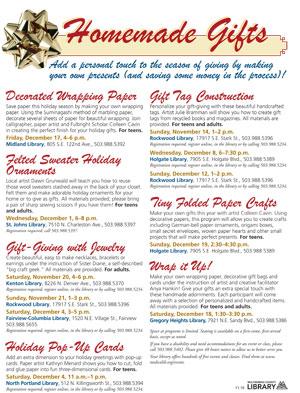
How can we attract new faces to our regularly scheduled programs? It is all about the packaging! When product manufacturers experience stagnating sales, what do they do? They redesign their packaging! Coke went from those now collectible glass bottles to exciting cans of Coca Cola, Diet Coke, and Coca Cola Zero, then invited teens from around the world to “Move to the Beat” of London 2012. Such package redesign has been a driving force in the transformation of many great brands, and it is a perfect model for revamping programs. Just think about Cheerios, those little circles of oats stuck in every baby’s car seat now chosen by their parents and grandparents to help lower cholesterol. For libraries, the time to start changing the package (without necessarily altering the content) is when we want to reach new audiences or offer something new. But you just can’t schedule a redesign; there has to be a strategy behind the decision and a plan to carry it into effect. So let’s take a look at when we should think about re-marketing a program (or totally changing brands) and where to begin.
I will be sharing our experiences at Multnomah County (Ore.) Library, a library that is consistently rated as one of the best and busiest libraries in the nation, receiving national recognition for its services, and ranking second in circulation only to New York Public Library. As Oregon’s largest public library, the library serves nearly one-fifth of the state’s population with a wide variety of programs and services. In November 2012, the community showed their continued support of the library by approving a measure to create a permanent library district to fund library services and hours beginning in 2013.
Does Packaging Matter?
While working in a library we are particularly aware of the old adage “don’t judge a book by its cover.” However, it is part of our nature to assess something upon first glance. That it makes it all the more important to make a great first impression. Oftentimes, the first place that a patron learns about a program is from an event listing, a flyer, or, increasingly, through social media. Therefore, when developing a program, the title and the description can have a major impact on who attends, or does not attend, regardless of the content of the actual program. Studies show that people will spend, on average, eleven seconds looking at a flyer, so we don’t have much time to convince them.
In deciding to attend a program, especially in an unfamiliar venue, the title of the program and the wording of the description can influence who attends. In marketing children’s programs we learned that while we want patrons to understand how much their children will gain from the experience, we were using some wording that might actually make parents and grandparents wary of attending. Words like “literacy” and “parenting” can actually have negative implications for caregivers, who believe that they are being targeted because they are deficient in some way. Patrons are first looking for fun, high-quality classes and events; that we give them much more is our strength. Paying attention to the words and phrases that are used in describing a program can have a major impact on attendance. “Good Things to Eat” vs. “Nutritional Facts about What We Consume” or “Typing for Kids” vs. “Children’s Survival Tactics in the Electronic Age.”
Another instance where a change of words led to new audiences was with a successful series of programs that Multnomah County Library had been offering called “Tools for Midlife Transition.” While this series was developed for older adults, the information shared could be useful to anyone experiencing transition in his or her life. When we began looking at expanding the program, the first thing we did was change the title to “What’s Next? Surviving Change.” Next we made minor tweaks to the program description to reach the intended audience. The old program description began: “How will you get through the economic crisis, the loss of your job, retirement, or other changes? Are you vaguely disappointed in life as you enter midlife?” Now the program inquires, “Just laid off? The economy got you down? Newly single? This is your chance to start over!” These minor changes resulted in an audience that ranged from students trying to figure out what to do after college to adults of all ages looking to start a new career or begin a new phase of life.
When Is the Time to Redesign?
It is not always necessary to start mixing things up, but in the following situations, you may want to consider making a change:
- reviving interest in existing programs
- offering something new;
- looking to reach new audiences
- expanding program offerings
Reviving Interest in Existing Programs
Umbrella marketing, or promoting multiple programs under a single marketing campaign, is a great way to revive interest in long-time programs. This type of promotion facilitates new program introductions by providing a familiar program alongside an unfamiliar one, which can lead patrons to attend programs that they may not have otherwise found. For example, each year during the holidays, we turn all of our craft programs into gift-making programs. During the course of the year, we work with community artists and typically offer programs such as paper crafts, scrapbooking, and other creative activities. Some minor marketing tweaks include turning a paper marbling workshop into “Decorated Wrapping Paper” and a popular jewelry-making program into “Gift-Giving with Jewelry,” resulting in a whole series on holiday gifts. This introduces patrons to new programs by marketing them with ones they already enjoy.

Offering Something New
This past winter we began offering a new program on how to learn basic Mandarin Chinese, but were uncertain there would be an audience devoted to this eight-week series. Since the program began in January, and learning a new hobby or skill is a popular resolution, we decided to market this program with other programs that we were already offering and package them together as a series to help people stick to their New Year’s resolutions. We revamped some popular programs that were held throughout the year such as “Be Happy” (previously titled “Habits of Highly Happy People”) and “Eat Right” (formerly known as “Eating for a Healthier Lifestyle”) and thus created our new series. Sort of like the whole “if you like this, then try this” approach, this marketing concept exposed more people to new programs by grouping them under a single topic. In other words, eating right and learning Mandarin Chinese will make you happy.
Looking to Reach New Audiences
In an effort to achieve greater gender diversification amongst our audiences, we created a series of programs that would be of particular interest to men. While we were already offering programs that could appeal to both genders—from basic gardening and raising goats to lectures on the science of time travel and local baseball history— we were continuing to have a mostly female audience. However, by adding in a few programs that were stereotypically male, such as a barbecuing workshop ( i.e. a place of male refuge) and a program on wilderness survival skills, we were able to market these programs along with some of the other programs that we hold regularly in order to increase overall male attendance. By grabbing their attention with these traditionally male-focused programs, we could then introduce them to a gardening or cooking program that they might have previously ignored.
Expanding Program Offerings
In partnership with our Board of County Commissioners, the Multnomah County Library put together a new initiative for job seekers titled “Libraries for Livelihood.” The goal of the program was to connect residents with the resources they need to help them find employment opportunities. The library was already providing many valuable resources that were available throughout the year, including computers designated exclusively for job hunters and workshops that offered assistance to job seekers. However, for “Libraries for Livelihood,” we increased our offerings and added in some new, exciting classes such as “Ten Resume Writing Mistakes You Don’t Want to Make,” a class designed to help unemployed residents use social media to reenter the workforce, and a class to help job seekers polish their interviewing skills by participating in a mock interview with a career counselor. Even though the series included many programs that we were already offering, by combining everything under one umbrella and relaunching the series as a comprehensive program on job searching, this allowed us to highlight the many resources that we were already offering while reaching new audiences.
Through these efforts, we successfully increased awareness of and interest in our programming. Our “Libraries for Livelihood” interview sessions were all waitlisted, and an attendant of the resume workshop shared her satisfaction with this series: “I had no idea you offered such helpful programs. This was the most informative class I’ve taken.” We were able to reach many patrons who were active library users but were not aware of the breadth of classes being offered. When the Mandarin Chinese class series was first scheduled, there was not as much interest in the class as we had anticipated. After remarketing the program and offering it again, the class had a waitlist as long as the number of participants. We therefore scheduled an additional series at a different library branch to accommodate the growing interest. However, some programs are popular enough without a redesign. After further marketing some of our craft programs, which were already quite popular, we started to have to turn people away from certain workshops. We quickly realized that we would need to be more intentional in our marketing efforts.
Start at the Shelf
Redesigns need to be guided by an understanding of what people are most interested in and how they can find it without too much trouble. And the best way to do this is to go to the source. In packaging, one must have an understanding of the retail environment, how shelving, merchandising and competitive tactics impact the way shoppers encounter packaging at the shelf. In programming, we must understand how patrons seek out information about a program. At Multnomah County Library, we therefore recently revamped our program evaluation forms. Under the section asking how they heard about the program, which at one time only listed a few options, we now have twelve: the library’s website; e-newsletter; Facebook; Twitter; shared by someone on social media; heard from a friend; an email from the library; a flyer/brochure/poster in the library; from a staff person; in a non-library publication; at school; or just happened to walk in at the right time. Despite the many ways that information is shared, and the rise in social media, the majority of our patrons still report that they find out about programs when they are in the library either through a flyer, poster, brochure, or staff member.
Through our evaluation process (and just plain common sense), we have learned that patrons are likely to attend programs that are more fun than educational. While everyone likes to attend music concerts and art classes, the more “educational” programs, especially those involving finances, are a bit less interesting. Throughout the year we had offered programs on managing your money, dealing with debt, saving for retirement, and various budgeting and savings opportunities. However, these programs did not see the same attendance as other, more “fun” programs. In addition to making small changes such as renaming programs and changing the wording, we tried to make them more appealing by focusing on topics that we already knew were of interest to our patrons, then “sneaking” in relevant financial information. For our budgeting workshops, we gave each program a theme based on the time of year, such as “Holiday Shopping on a Budget” during the winter and “Planning a Vacation on a Budget” for the summer. Instead of just having an accountant giving these presentations, we partnered them with a travel agent and the host of a radio shopping show. The financial aspects of these programs did not overwhelm the people who just wanted to have fun.
So What Do You Do Next?
While it is great to attract new faces, it is also important to remember your core, loyal patrons and make sure they understand that the program is basically the same, even though its package may look a little different. A few years ago we witnessed one of the most publicized redesign missteps since the introduction of New Coke. Tropicana created a new logo and its loyalists verbally protested for months. Sales plummeted by 20 percent, forcing Tropicana to quickly return the original packaging to the shelves. What went wrong? PepsiCo underestimated the emotional bond that very loyal consumers had to the original packaging. Rebranding without first doing your homework, understanding and communicating with your audience, having goals, and/or to fix something that is not broken, can have disastrous results. The 2012 London Olympics Committee wasted $800,000 trying to modernize the Olympic rings. No one else wanted to see such a change. Since we cannot afford to make these types of mistakes, it is important to remember that change is good … but it must serve a purpose.


